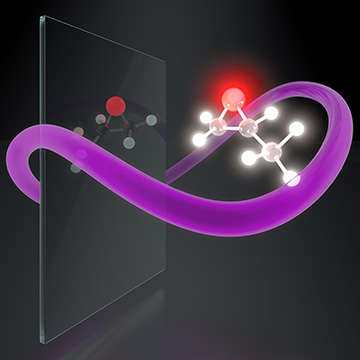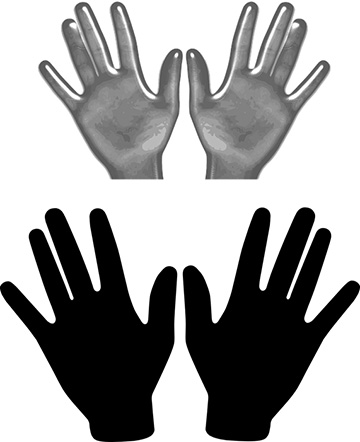
An international research team has developed a method for creating “synthetic chiral light” that selectively interacts with one of the two versions of a chiral (left- or right-handed) molecule. [Image: Steven Roberts]
The ability to detect chirality—whether the molecules of a given chemical substance twist in a left-handed or right-handed sense—is central to experimental chemistry. It’s particularly important to drug development, where the difference between left-handed and right-handed variants, or enantiomers, of a specific molecule can mark the difference between a life-saving substance and a lethal one.
Chiral or circularly polarized light has long been used to identify this molecular “handedness.” But a key hurdle has been that so-called chiroptical interactions between circularly polarized light and molecule-scale matter tend to be extremely weak, limiting the application scope of chiral light to useful but relatively crude molecular sensing.
Now, an international team of scientists has put on the table a very different potential approach to using light as a probe of molecular handedness (Nat. Photon., doi: 10.1038/s41566-019-0531-2). Dubbed “synthetic chiral light,” the light fields that the team describes reportedly could bring about chirally selective light–matter interactions far stronger than those available using ordinary circularly polarized light. Those strong interactions, the researchers believe, could enable new approaches for ultrafast sensing of molecular handedness in mixed chemical samples, and for using laser beams to separate species based on their chirality—a potential boon to chemical and drug development.
Weak interactions
Because left- and right-handed enantiomers are chemically identical and differ only structurally, chemical means alone can’t distinguish them. Instead, their chirality must be inferred from their interaction with another chiral agent. Circularly polarized light, which sweeps out a helical pattern in a left- or right-handed sense as it propagates, offers one obvious candidate for such an agent.
The problem, however, has been that the helicity of the light plays out over a micrometer-scale distance—the helix “pitch”—that’s orders of magnitude larger than the angstrom-scale dimensions of the molecule. As a result, the molecule feels very little of the light field’s spatial chirality. Further, the helicity fundamentally hinges on the light’s magnetic-field component, which interacts only weakly with matter.
Instead, the business end of the light–matter interaction takes place via the light’s much stronger electric-field component, under the so-called dipole approximation. In that approximation, the electric-field vector interacts with the molecule not across space in a chiral helix, but entirely locally in a 2-D plane orthogonal to the light’s propagation direction.

[Image: Pixabay]
That means that, in the most important part of the light–matter interaction, the sense of chirality implied by the light’s circular polarization and its helical propagation essentially disappears. The light’s most dominant interactions with matter thus can't be used to distinguish between left- and right-handed molecules—even though the light field itself is chiral.
Making “synthetic” chiral light
The team behind the new work, led by scientists at the Max-Born-Institut, Germany, and including researchers affiliated with other institutions in Germany, Israel, Italy and the United Kingdom, wanted to see if there was a way to squeeze a little chirality into the dipole approximation. Doing so, the researchers realized, would allow them to take advantage of the electric-field component—the strongest part of the light–matter interaction—in distinguishing between left- and right-handed molecules, rather than relying on the weak interactions of the magnetic-field component of spatially helical light fields.
The problem boiled down to finding a way to make the sense of the light’s electric-field vector locally chiral at any given time and any point in space. To get there, the researchers began by digging into the physics of the light–matter interactions in the dipole approximation, and how higher-order electric-field correlations buried therein might be used as an alternative window into the chirality of molecules.
Through that analysis, the researchers were able to zero in on several high-order, entirely local correlations whose values indeed related to chirality. Further, those correlations could be accessed via nonlinear optics, using two converging laser beams—each containing two orthogonally polarized frequency components, ω and 2ω, separated by an adjustable phase difference ϕω,2ω. It turns out that in such a light field, different nonlinear light–matter interactions such as second-harmonic generation and multiphoton absorption follow different pathways, and show different interference patterns, depending on whether the molecular matter is non-chiral or chiral—and, if chiral, on the specific handedness.
The system also includes a built-in control knob: By tuning the relative field strength and phase difference between the two frequency components, one can control the handedness of the synthetic chiral light, and thus the handedness of the molecules with which it will strongly interact. “We now have,” the authors write, “a chiral photonic reagent, whose handedness can be tailored to control multiphoton interactions, with extremely high efficiency.”
Toward better chiral-molecule manipulation
The researchers suggested an experimental setup that could be used to create such synthetic chiral light in the lab. The proposed setup starts with a single, linearly polarized 1770-nm laser beam, which is passed through a frequency-doubled nonlinear BBO crystal to create a beam with orthogonal polarization components at the two different frequencies.
The beam is then divided using a beam splitter, and passed through calcite wedges to allow the phase difference between the frequency components to be controlled. The two beams then converge at an angle of 10 degrees to one another onto a target (for example, a molecular gas), and a detector at the back end captures the high harmonics from the resulting, chirally selective nonlinear interactions.
Such a setup, the team’s numerical simulations suggest, “enables full control over the intensity, polarization and propagation direction” of the nonlinear optical response related to randomly oriented chiral molecules. That level of control, the researchers believe, could allow for real-time monitoring of the handedness of molecules undergoing chemical reactions in the lab—and even for exotic possibilities such as using light to “imprint” a left- or right-handed chiral sense on non-chiral matter.
In addition to researchers from the Max-Born-Institut, the study included scientists affiliated The Technion, Israel; Technische Universitaet Berlin and Humboldt-Universitaet zu Berlin, Germany; Universite degli Studi di Trieste, Italy; and Imperial College London, U.K.
